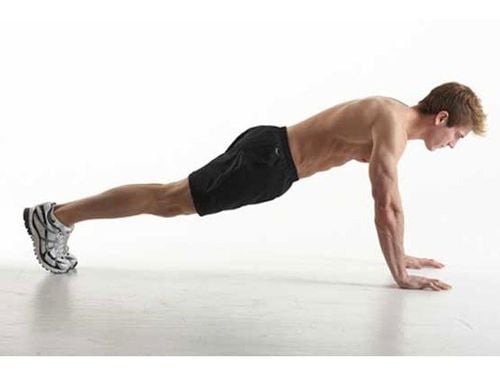Push-ups are an exercise that strengthens both the upper body and abdominal muscles. If done correctly, this exercise will work on the chest, shoulders, triceps, back, abdominal muscles and even the legs. You can do push-ups as part of a full-body workout, a daily fitness exercise. Below are some suggestions for the most effective push-ups that you can refer to.
1. Benefits of push-ups
Push-ups often affect the upper body muscles such as: deltoid muscles in the shoulders, chest muscles, triceps, forearms and back muscles. When doing push-ups, the abdominal muscles that are often activated are: rectus abdominis and transverse abdominis. Because push-ups involve many muscle groups, this is a combination exercise that is worth trying out.
In daily life, you often have to use your hands to push objects, from doors to carts, carrying goods... Practicing push-ups effectively will help you perform the above functions more easily and reduce the risk of injury during heavy activities.
In addition, practicing push-ups is also a measure of overall fitness, helping you assess whether you need to exercise more to maintain your body in a healthy state.

2. Instructions for doing push-ups correctly
Step 1: Bring your body to the Plank position (high plank). Place your hands slightly wider than your shoulders. Note, do not sag your back or push your hips up. The body forms a straight line from head to toe. Place your feet close together or a little further as long as the practitioner feels comfortable.
Step 2: Contract your abs and tighten your core by pulling your belly button toward your spine. Tighten your abs throughout the entire push-up.
Step 3: Inhale, slowly bend your elbows and lower your body until your elbows are perpendicular to the floor.
Step 4: Exhale as you tighten your chest and push your elbows back to the starting position. Repeat the movement for the required number of reps.
SEE MORE: Do push-ups reduce belly fat?
3. Common mistakes when doing push- ups
It is easy to make mistakes when doing push-ups when you are tired or your muscles are not strong enough to maintain the movement. Here are some common mistakes when doing push-ups:
3.1. Slouching
The most common wrong posture is slouching when doing push-ups. The cause is not tightening the muscles properly and keeping the body stable during the movement. Slouching not only causes bad form but can also cause back pain.
To correct this mistake, you can practice the Plank position separately first to practice tightening the abdominal muscles. Once you have mastered it, switch to the kneeling push-up position to practice keeping the body stable and the back straight while practicing.

3.2. Bent neck
Your neck should be in line with your head and spine, eyes looking down at the floor and the top of your head facing the opposite direction. If you tilt your chin up or lower your head to the point where you can see your toes, your neck is not straight and needs to be adjusted.
3.3. Locked elbows
When bringing your body to the highest position, many people have the habit of locking their elbows because they are tired and want to rest a bit. However, this is a mistake because this will put pressure on the joints, leading to muscle strain or injury. During the exercise, always keep your elbows slightly bent. If you feel tired, it means it is time to rest before doing another set.
3.4. Placing your hands too far in front
When in the high plank position, if your hands are placed further away from your body than your shoulders, it means that more pressure is being put on your shoulders. Although you can adjust the width of your hands to increase or decrease the difficulty of the push-up exercise, the standard position of your hands must still be placed directly under your shoulders.
3.5. Limited range of motion
If you just lower yourself a little and then immediately lift yourself back up, you won't get the full benefit of the push-up exercise. In this case, you should switch to easier push-up variations (like knee push-ups or incline push-ups...). There you can perform the full range of motion with significantly less difficulty.
Learn about the most common mistakes when doing push-ups and adjust each movement one by one. If you have difficulty with the standard push-up position, you can consider switching to easier variations like wall push-ups, incline push-ups...
SEE MORE: Instructions on how to do push-ups properly for women

4. Push-up variations
Whether you're new to exercise or looking for a more challenging workout, there are variations to suit your needs. Once you've changed your workout, you can change the impact on your muscle groups. Beginners can do easier versions to build up their endurance before doing standard push-ups, while advanced exercisers can try new ways to work their muscles.
Here are some easier variations for beginners:
- Incline Push Ups: If doing a standard push-up is too difficult, you can start by doing push-ups against a table or bench. Stand far enough away from the object so that your neck, back, and legs form a straight line. Use the same push-up technique as above to lower yourself down until your elbows are at a 90-degree angle, then use the force to lift yourself back up. Keep your abs tight throughout the exercise.
- Bent-Knee Push Ups: This is a modified version of the standard push-up, performed on the knees rather than the balls of your feet. Keep your knees, hips, and shoulders in a straight line. Do not raise your hips during the exercise.
Here are some advanced push-up variations that increase the difficulty and work your muscles in different ways:
- Medicine-Ball Push Up: Perform the same as the standard push-up but place one hand on a ball. This modification allows more range of motion in the shoulders, which helps increase shoulder stability.
- Decline Push Ups: This is a more complex push-up, with the raised leg placed on a stable box or bench. You can adjust the height of the box to increase or decrease the force applied to the shoulders during the push-up.
- Diamond Push Up: Diamond push-ups are performed with your hands placed close together so that the index finger and thumb of one hand touch the other to form a diamond shape. Then, you perform the push-up as usual, applying pressure to both hands.
To do push-ups properly and effectively, you should avoid practicing if you have a shoulder, wrist or elbow injury. Talk to your doctor or physical therapist to see if the exercises you are doing are suitable for you. If you have signs of shoulder pain, hear clicking sounds in your shoulder or feel other signs of discomfort, do not force yourself but stop the exercise.
Please dial HOTLINE for more information or register for an appointment HERE. Download MyVinmec app to make appointments faster and to manage your bookings easily.
Reference source: Verywellfit













